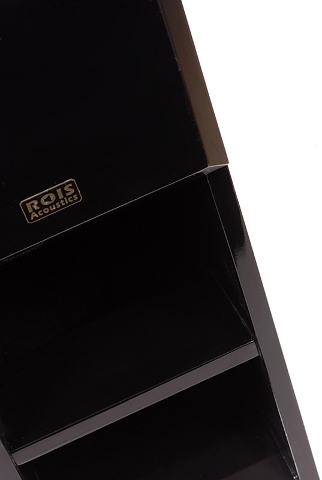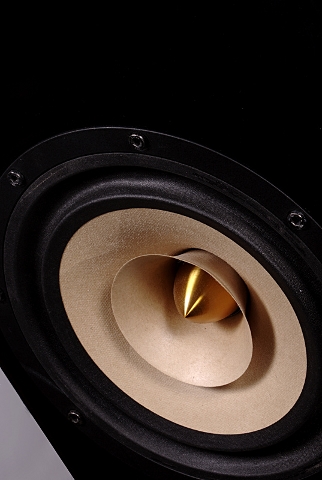about Audio, High Fidelity
& Home Entertainment technologies
pid: 607-2025/10/01 (v1.2)
Privacy Policy

Listening evaluation of the Kalypso took place in two parts, the only difference between them being the amplifier used to drive the loudspeaker. For most of the time the usual reference system (Teac Esoteric P70/D70, dCS Puccini U-Clock, Melos Plus Series Line, Parasound HCA-3500, ATC SCM-50PSL) was used but for a time period the (probably "too much") HCA-3500 was replaced by an FOS 211, a tube-based, single ended amp, based on 211s. The choice of this amplifier was based on the fact that one of the key advantages a design, such as the Kalypso Passive offers, is that they can be easily driven by low-power amplifiers.
Correct placement of the loudspeaker in the room was not difficult. Obviously its size and especially its depth, which is about 60 centimeters, dictates a room space somewhat larger than this of an average floorstander but this should be expected. In the final set-up, after some experimentation, the loudspeakers were spaced apart little more than 2.5 meters with the distance from the back wall being approximately 20 cm.
The first impression one gets while listening to the Kalypso is that the loudspeaker is pleasant, soft and mild, with a good balance between character and tonal accuracy. The listener enjoys a very well-focused stereo image, with a clear definition of its boundaries and a good sense of depth, while the loudspeaker gives a laid-back impression of which you will never get tired, even at high levels. High-level listening is not a problem with Kalypso, even with low wattage amps, and the loudspeaker is capable of reproducing the macro-dynamics of any program without any serious limitations, in a medium-sized room. The long-throw suspension driver probably plays a vital role here. Even with a digital room equalization processor, which occasionally drives the woofers hard, Kalypso behaves smoothly. Although a level limit obviously exists, it is quite high and, most importantly, you can approach it even with small amplifiers. The loudspeaker appeared somewhat lenient, with some harsh recordings sounding a bit rounded and more praised than actually are while maintained a feeling of brightness and dynamism that no one expects from an 8-inch driver.
Rois' people have done a great job in terms of Kalypso's lower frequency behavior. The loudspeaker featured a good bass extension but, even more, appeared to be well controlled with very good capacity in detail description which was not hidden behind an excessive bass performance. The loudspeaker does not sound impressive at first, given its volume and overall physical presence, but in a short time, you realize that it comfortably fills the space and maintains a balance and a feeling of correct scale for the bass instruments, both acoustic and electronic. Rhythm section was pleasant, with a sense of completeness and of good speed in a way that would fully satisfy the discerning listener.
Midrange is probably the strongest side of Kalypso's sound character. Fast, descriptive and more than just capable of handling a complex program, offers the listener the opportunity to enjoy a "real-life" feeling during a listening session. The whole event is staged at the right distance from the listener and the end result I got with a lot of recordings was much less "aggressive" than the reference loudspeaker (which -on the other hand- excels in detail and transparency), thus creating the impression that the program will flow better and you will not ever need to face hardness again (hence the tolerant character I described in the first impressions paragraph). No doubt, Kalypso had a particular character to superimpose here, but this did not bother me at all, on the contrary, in most cases this could be a desirable trait for lots of audiophiles out there. Combine this behavior with a single ended tube-based amplifier and you will be facing a system that becomes part of the music event, describing the human voice with an excellent feeling of presence both in solo (with very good air and clarity) and choir works (with very good feeling of size and movement), the final result being quite impressive.
The high-frequency range could be considered as an extension of the mid-band in its character. Kalypso sounded soft and pleasant, with clear presence and without the slightest trace of harshness. The loudspeaker offered a good feeling of harmonic richness and appeared enough transparent, albeit slightly dry (a feature that would become evident with high resolution recordings that have some content above the 20kHz and normally tend to sound very airy) and with excellent body and release times for the percussive music instruments with serious high frequency content. In comparison with the reference loudspeaker, Kalypso sometimes offered the feeling of being a little slow on the attack but, overall, the result is a performance without anything important missing and one that is satisfactory with every type of music program.
Finally, the fact, that we are dealing with a single driver loudspeaker that resembles a point source quite good, gives some interesting possibilities on the subject of the stereo imaging. Kalypso proved quite capable of passing the relevant recording attributes and offered a very good description of space, position and movement of the various audio objects present on the mix, handling difficult details (such as phase reversal) with great success, and creating a sound field of remarkable quality.
Conclusion
There is no doubt that Rois' effort of to create a large floorstanding loudspeaker based on the widespread idea of simplicity (featuring a full range driver, without any crossover) is highly successful. Kalypso Passive is an easy to drive, high sensitivity loudspeaker with very good tonal balance and a carefully reckoned sound character, one that will honor all kinds of music and inevitably won our appreciation. Restful, dynamic and pleasant to listen to, emerges as a first-class proposal for those audiophiles looking for a loudspeaker suitable to be driven by their single ended tube amplifier and those who believe that the simplest is ultimately better. Moreover, it is a very good foundation on which I hope Rois will base their active, digitally compensated model, the one that I will eagerly await...
Previous | Next | More Reviews



